
[sws_button class=”” size=”sws_btn_medium” align=”” href=”https://chicagosinfonietta.org/event/1213concert-i/” target=”_blank” label=”Buy Tickets!” template=”sws_btn_default” textcolor=”ffffff” bgcolor=”892d3c” bgcolorhover=”5a1c26″][/sws_button] [/one_half] [one_half_last]
[sws_button class=”” size=”sws_btn_medium” align=”” href=”https://chicagosinfonietta.org/wp-content/uploads/Chicago-Sinfonietta-Performing-Art.pdf” target=”_blank” label=”Program Notes” template=”sws_btn_default” textcolor=”ffffff” bgcolor=”892d3c” bgcolorhover=”5a1c26″] [/sws_button] [/one_half_last]
Performance. Art.
Our opening night concert will display flights of virtuosic musicianship married to unique compositions, all designed to pull at your head, heart, and quite possibly feet. Along with the music, a strong dose of movement and color will engage your sense of sight as well.
It would be wise to be there when the first note is played, lest you miss all the surprise and delight of our season introduction.
THE ARTISTS
[one_half]Mei-Ann Chen, Music Director and conductor
 Performance. Art. picks up where Mei-Ann Chen’s first season as Chicago Sinfonietta Music Director left off. It was a year filled with firsts, including her stunning debut at Millennium Park’s Pritzker Pavilion and several performances of works not previously heard on Chicago stages. The season earned two awards from the League of American Orchestra: Mei-Ann won the Helen M. Thompson Award, given to a music director every two years to recognize their impact and potential for a significant national career, while the orchestra earned a First Place Award for Adventurous Programming. Performance. Art. continues the adventure.
Performance. Art. picks up where Mei-Ann Chen’s first season as Chicago Sinfonietta Music Director left off. It was a year filled with firsts, including her stunning debut at Millennium Park’s Pritzker Pavilion and several performances of works not previously heard on Chicago stages. The season earned two awards from the League of American Orchestra: Mei-Ann won the Helen M. Thompson Award, given to a music director every two years to recognize their impact and potential for a significant national career, while the orchestra earned a First Place Award for Adventurous Programming. Performance. Art. continues the adventure.
As the Sun-Times’ Andrew Patner has remarked, “Mei-Ann Chen has shown that she was born to lead this group. She plays and speaks from the heart, the body and the head, and the audience and players have embraced her.”
Mei-Ann Chen’s complete biography can be found here.
[/one_half] [one_half_last]
She talks about the concert in this video clip, where she also hints at something special for opening night. What is it? You’ll have to attend to find out.
PROJECT Trio
Greg Pattillo, flute; Eric Stephenson, cello; Peter Seymour, bass
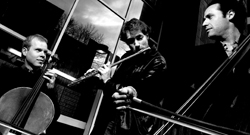 When PROJECT Trio uploaded their first video to YouTube four years ago, it went viral, garnering millions of views in just the first week. In 2012, they are up to an astounding 71 million views and have 78,000 subscribers. What the heck is going on here?
When PROJECT Trio uploaded their first video to YouTube four years ago, it went viral, garnering millions of views in just the first week. In 2012, they are up to an astounding 71 million views and have 78,000 subscribers. What the heck is going on here?
PROJECT Trio push the boundaries of chamber music with a high octane mix of classical, jazz, hip-hop, and rock. The Brooklyn-based ensemble is one of the most popular classical groups of its generation. Its virtuosic young members deftly wed classical precision and technique to a genre-hopping sensibility. Downbeat Magazine has praised them as “packed with musicianship, joy, and surprise.” All three members have solid classical credentials (Cleveland Orchestra, New World Symphony, Aspen Festival Orchestra) but it’s what their peers say that grabs your attention, like this quote from the principal trumpet player at the San Francesco Opera: “PROJECT Trio really has it all. They combine the fire and refinement of the finest classical chamber ensembles with the stage presence and energy of rock stars”.
Their bio and lots of other cool stuff can be found at their website.
[/one_half] [one_half_last]
As mentioned earlier, they have some pretty cool YouTube videos. Start with this one of Fast, one of the selections they’ll be performing with the Sinfonietta.
Eric Goldberg and Shuya Gong, marimba and percussion
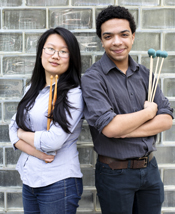 If you look up “Whiz kids” in the dictionary, there’s a good chance you’ll see a picture of Eric and Shuya next to the entry. Between them, they have won the CSO Young Artist Competition a remarkable 3 times, one of those as a duo. They have been featured on NPR’s From the Top twice and also on WFMT’s Introductions. They’ve performed with the CSO under the direction of Mei-Ann Chen, and were special guest performers at the Chicago Sinfonietta’s 25th Anniversary Ball earlier this year. They’ve played Carnegie Hall. All this, and they’ve just begun their senior year at Whitney M. Young Magnet High School.
If you look up “Whiz kids” in the dictionary, there’s a good chance you’ll see a picture of Eric and Shuya next to the entry. Between them, they have won the CSO Young Artist Competition a remarkable 3 times, one of those as a duo. They have been featured on NPR’s From the Top twice and also on WFMT’s Introductions. They’ve performed with the CSO under the direction of Mei-Ann Chen, and were special guest performers at the Chicago Sinfonietta’s 25th Anniversary Ball earlier this year. They’ve played Carnegie Hall. All this, and they’ve just begun their senior year at Whitney M. Young Magnet High School.
Yes, they’re only in high school.
Their rhythmic virtuosity is an absolute wonder to behold as they fly across the marimba and assorted percussion instruments, as the accompanying video demonstrates.
[/one_half] [one_half_last]
You can see and hear them in this clip from their appearance on From the Top earlier this year. The piece is by composer Avner Dorman, who also composed Spices, Perfumes, Toxins! which will be performed at Performance. Art.
THE COMPOSERS
Johannes Brahms
Hungarian Dance No. 5
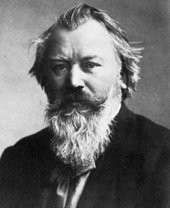 The concert begins with Brahms’ Hungarian Dance No. 5, based on a csárdás by Kéler Béla titled “Bártfai emlék.” Csárdás were the club music of the 19th century, the song the DJ played to get everyone on their feet. Csárdás, roughly “inn-dances,” are songs that were traditionally played within taverns or inns; they lightened up the room with a lively rhythm and melody that an audience could dance to, sometimes raucously, other times in step. Tonight’s performances will brush away some of the accumulated dust that clings to classical music to reveal the popular music within.
The concert begins with Brahms’ Hungarian Dance No. 5, based on a csárdás by Kéler Béla titled “Bártfai emlék.” Csárdás were the club music of the 19th century, the song the DJ played to get everyone on their feet. Csárdás, roughly “inn-dances,” are songs that were traditionally played within taverns or inns; they lightened up the room with a lively rhythm and melody that an audience could dance to, sometimes raucously, other times in step. Tonight’s performances will brush away some of the accumulated dust that clings to classical music to reveal the popular music within.
The Hungarian Dances were a set of 21 pieces that Brahms based on traditional folk themes. Originally composed for piano, these new pieces were immensely popular when completed in 1869; they brought something innovative and new that simultaneously hearkened back to familiar melodies.
Johannes Brahms is, of course, one of the “Three Bs” of classical music (along with Beethoven and Bach). More on his life and works can be found here.
[/one_half] [one_half_last]
The instantly familiar strains of Hungarian Dance No. 5 are evident in this cleverly humorous use from Charlie Chaplin’s classic film The Great Dictator.
PROJECT Trio
Fast, Random Roads Suite, Bach’s Bourée
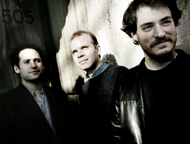 PROJECT Trio brings a fresh approach to the classic repertoire, but they are also increasingly active as composers of original new music. We’ll hear a little of both at this concert. Fast is emblematic of PROJECT Trio’s original work—rhythmically complex, melodically innovative and energetic. They will perform it tonight by themselves as a trio, and then the orchestra will return to join them on a special arrangement of another original work.
PROJECT Trio brings a fresh approach to the classic repertoire, but they are also increasingly active as composers of original new music. We’ll hear a little of both at this concert. Fast is emblematic of PROJECT Trio’s original work—rhythmically complex, melodically innovative and energetic. They will perform it tonight by themselves as a trio, and then the orchestra will return to join them on a special arrangement of another original work.
Audiences of a certain age might remember a previous modern take on J.S. Bach’s Bourrée in E Minor for lute – but not on a lute. The rock band Jethro Tull, led by virtuoso flutist Ian Anderson, wowed arenas packed with ecstatic fans with their jazzy rendition in the mid 1970s. PROJECT Trio flutist Greg Pattillo was aware of this history when he brought his distinct beat boxing style to the tune a few years ago.
The three movement Random Roads Suite is another PROJECT Trio original that will receive a full orchestral treatment at this concert. Arranger Drew Baker, a Chicago-based composer and pianist, has created a score that, in his words, “is intended to highlight the virtuoso chops of the trio while at the same time creating an intricate and coloristic interaction between soloists and orchestra.”
[/one_half] [one_half_last]As noted above, YouTube is filled with videos that show off PROJECT Trio’s chops and inventiveness. This one briefly showcases their deft interplay of classical technique, jazzy rhythmic sense, and hip-hop attitude. [/one_half_last] [one_half]
Avner Dorman
Spices, Perfumes, Toxins! (Mvt. 1)
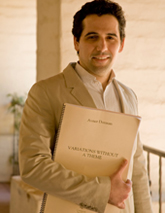 Avner Dorman has quickly risen to become one of Israel’s most successful and renowned composers. Dorman’s unique approach to rhythm and timbre has attracted some of the world’s leading conductors, including Zubin Mehta, Marin Alsop and Simone Young, to bring his music to international audiences. Mei-Ann Chen and the Sinfonietta now join this august company.
Avner Dorman has quickly risen to become one of Israel’s most successful and renowned composers. Dorman’s unique approach to rhythm and timbre has attracted some of the world’s leading conductors, including Zubin Mehta, Marin Alsop and Simone Young, to bring his music to international audiences. Mei-Ann Chen and the Sinfonietta now join this august company.
At the age of 25, he became the youngest composer to win Israel’s prestigious Prime Minister’s Award and that same year he was awarded the Golden Feather Award from the Israeli Society of Composers and Publishers. Since coming to the United States, Dorman has received several additional international awards.
According to Dorman, “the title Spices, Perfumes, Toxins! refers to three substances that are extremely appealing, yet filled with danger. Spices delight the palate, but can cause illness; perfumes seduce, but can also betray; toxins bring ecstasy, but are deadly.” The first movement—Spices—draws its inspiration from the regional music of the Middle-East, Israel, and the Indian subcontinent. Tonight’s performance will be a showcase for the percussive talents of our young guest artists Eric Goldberg and Shuya Gong.
Avner Dorman has his own website filled with videos, music, and a downloadable biography.
[/one_half] [one_half_last]
In this clip, the Israel Philharmonic Orchestra under Zubin Mehta performs the final few minutes of Spices!
Igor Stravinsky
The Firebird Suite
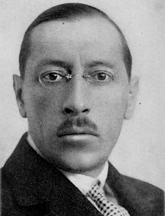 It is fitting that in a performance filled with rhythmic energy and danceable rhythms, the evening concludes with a score from a ballet. In 1909, the Russian ballet and dance impresario Sergei Diaghilev formed the dance company Ballets Russets. A popular dance troupe in Paris, Diaghilev and his compatriots—most notably the designer Alexandre Benois—were eager to make an even more indelible mark on the performance scene.
It is fitting that in a performance filled with rhythmic energy and danceable rhythms, the evening concludes with a score from a ballet. In 1909, the Russian ballet and dance impresario Sergei Diaghilev formed the dance company Ballets Russets. A popular dance troupe in Paris, Diaghilev and his compatriots—most notably the designer Alexandre Benois—were eager to make an even more indelible mark on the performance scene.
Even before the music was composed, Benois and choreographer Michel Fokine began creating the world of the piece, mixing inspiration from various Russian folk tales, including that of the mythical Firebird. For the music, the 28-year old Igor Stravinsky was approached and history was made.
Although Stravinsky would eventually move to Paris and become part of the artistic circle that included Pablo Picasso and T.S. Elliot, in 1909 he was still living in Russia and deeply steeped in its folklore. Firebird embodies this narrative and makes extensive use of Russian folk themes and motifs.
More on Igor Stravinsky can be found here.
This is certainly not Mei-Ann Chen’s first go-around with Stravinsky’s iconic masterpiece. Early this year, Maestro Chen led the Alabama Symphony in an all-Russian program that was assessed thusly by one review: “To say the orchestra was tight, taut and focused in Stravinsky’s ballet suite is an understatement. The musicians picked up on Chen’s energy early on, building momentum and getting carried away with the electrifying ambiance they created. The finale was breathtaking,” greeted by “one of the longest pre-intermission ovations in memory.”
Performance. Art. promises more of the same.
[/one_half] [one_half_last]
In this rare clip, Stravinsky himself conducts one of the work’s seven movements.
Research and copy by Don Macica. Design by Ryan Smith
